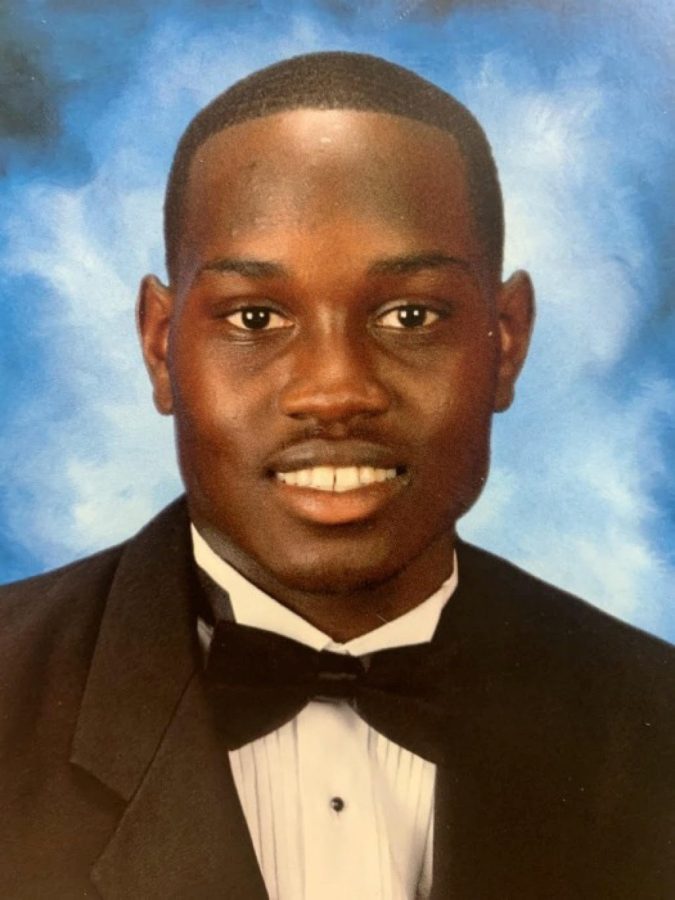UPDATE 11/29/21: Ongoing Ahmaud Arbery Trial Brings Up Discussion About “Racial Undertones” In The Case
November 14, 2021
On February 23, 2020, Ahmaud Arbery, a 25-year-old black man, was jogging Sunday afternoon when he was shot and killed by three white residents of a South Georgia neighborhood. Those men now stand accused of murdering Arbery.
65-year-old Gregory McMichael, his 37-year-old son Travis McMichael, and their neighbor, William Bryan;52 not only stand accused of murdering Arbery but each face nine charges including aggravated assault, false imprisonment and malice. They have not pleaded guilty.

The murder of Ahmaud Arbery was caught on video, and police photos were taken of the gunshot wounds that killed Ahmaud Arbery. In the autopsy report, obtained by CNN, Arbery was shot multiple times; the 13 gunshot pellets that had exited from Arbery’s back and 11 more that were recovered were the cause of his death. The report stated Arbery had also suffered from a “deep, grazing, shotgun graze” to his wrist as well as wounds to his upper and lower middle chest.
According to the New York Times, Gregory McMichael had seen Arbery jogging that morning and thought Arbery resembled a man who was suspected of several break-ins in the neighborhood. He then called Travis Michael.
As written in the police report, the men grabbed a .357 magnum and shotgun, got into a pickup truck, and attempted to chase and cut off Arbery. Moments before the chase began, a 911 call was dispatched, where a neighbor told the dispatcher that a “black man was inside a house under construction on the McMichaels block.”
In the police report, George McMichaels says he had yelled at Arbery to stop because he wanted to “talk to him.” As the group had approached Arbery, McMichaels stated “the unidentified male began to violently attack Travis and two men then started fighting over the shotgun at which point Travis fired a shot and then later there was a second shot.”
Other reports, including the police report, did not indicate that Arbery was armed.
Prosecutors have argued that racism was a key factor in this case, according to BBC News. Lead prosecutor Linda Dunikoski told the jury, “all three of these defendants did everything they did based on assumptions–not on facts, not on evidence.” Prosecutors allege that Travis McMichael used expletives and a racial epithet directed at Arbery as he was on the ground. The men deny racism.
Shortly after the shooting, the case was sent to George E. Barnhill, the district attorney in Waycross, Ga, who had recused himself from the case after Arbery’s mother argued that he had a conflict because “his son also worked for the Brunswick district attorney.”
He noted that the McMichaels were legally carrying their firearms under Georgia’s “open-carry law”; he cited the state law that writes, “A private person may arrest an offender if the offense is committed in his presence or within his immediate knowledge.”
Alongside this, Mr. Barnhill argued that if Arbery had attacked Travis McMichael, then Mr. McMichael was allowed to “use deadly force to protect himself” under the Georgia law.
In the cell phone video captured by Bryan, Arbery is seen on his daily jog by a residential road just outside of Brunswick. He is chased by the defendants in a pick up truck until they stop directly in front of him. The two men in the truck, both Travis and Gregory McMichael, get out with weapons and “confront” Arbery. Less than a minute later, Arbery was fatally shot.
Glynn Country Police Officer William Dugan, had responded to the scene shortly after finishing an off-duty job. He testified that he had found Arbery, lying motionless and face down on the ground, and a couple of other people nearby, which he would later identify to be the defendants. In the video, Duggan turns Arbery over onto his back, his shirt and shorts stained with blood, and says, “there’s nothing I can do for this gentleman.” EMS and fire personnel arrive shortly after.
According to WSB-TV Atlanta, the clip was leaked at the behest of Gregory McMichael because he thought it would “make his son look better.”
The video sparked nationwide protests and prompted Georgia lawmakers to make changes to their state’s criminal law, one of which included the state’s first hate crimes statute. It wasn’t until the video of the shooting was released that the men were arrested.
The selection process was a long one, but it began with a rocky start when of the 600 potential jurors, a nearly all-white jury was appointed to the trial of these men. Scholars and law experts argued that the “racial breakdown of the jury for the trial for Arbery’s killing is reminiscent of the Jim Crow era.” Prosecutors for the state accused defense attorneys of “disproportionately striking” qualified Black jurors.
Judge Timothy Walmsley responded saying, “One of the challenges that I think counsel recognized in this case is the racial overtones in the case… This is sort of the continuation of a conversation that I think will continue for a long time, with respect to this case…all the defense needs to do is provide that legitimate, nondiscriminatory, clear, reasonably specific and related reason.”
During the trial, Rev. Jesse Jackson and Rev. Al Sharpton attended court in support of the Arbery family. Defense attorney Kevin Gough, who was representing Bryan, attempted multiple times to remove the pastors from the courtroom, saying, “we don’t want anymore Black pastors coming in here.”
The judge denied his motions to remove the pastors.
UPDATE 11/29/2021:
The three men were all found guilty of felony murder.
Travis McMichael, who had fired the bullets that killed Arbery, was convicted of all the nine counts raised against him by prosecutors. These included “one count of malice murder, four counts of felony murder, two counts of aggravated assault, one count of false imprisonment of Arbery, and one count of criminal attempt to commit a felony.”
Greg McMichael was cleared from one count of malice murder but was convicted of “four counts of felony murder, two counts of aggravated assault, one count of false imprisonment, and one count of criminal attempt to commit a felony.”
As for William Bryan, he was convicted with counts of false imprisonment, aggravated assault, and a criminal attempt to commit a felony. However he was not found guilty for “a count of malice murder, one count of felony murder, and one count of aggravated assault.”
All three men now face a sentence of life in prison.



